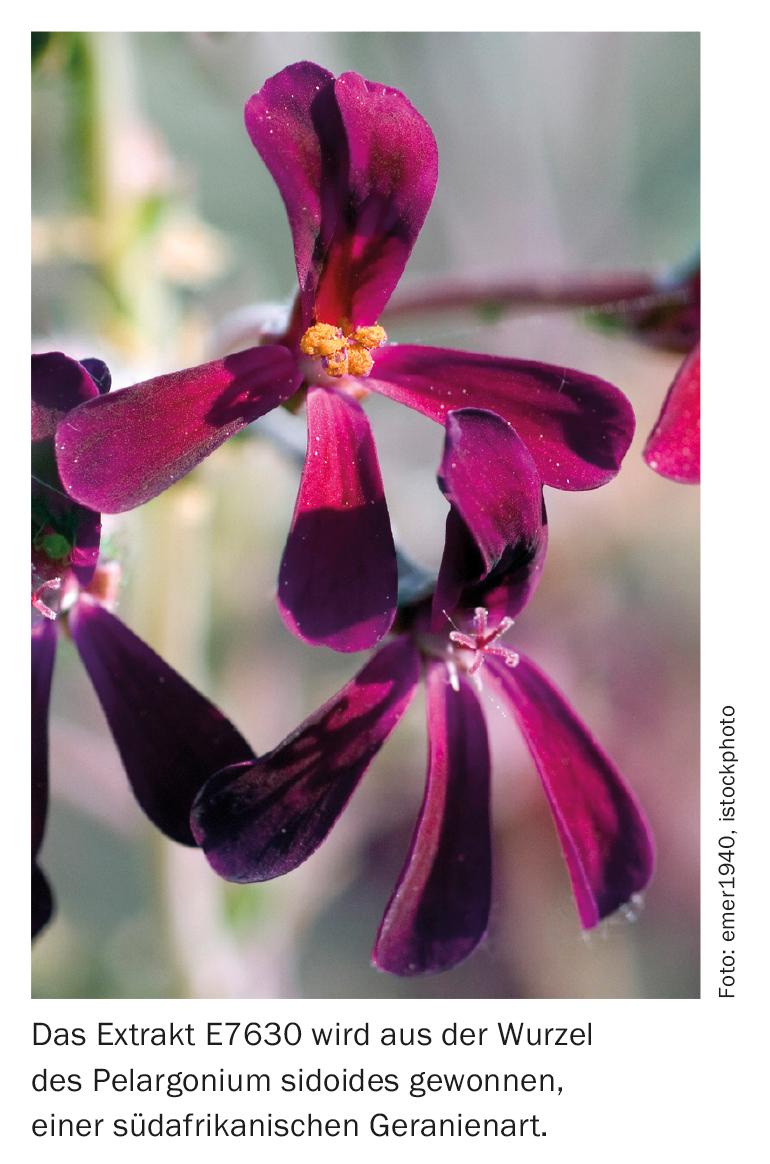Rhinoviruses are the most common cause of colds as well as exacerbations in asthma and COPD patients. One therapeutic option is the pelargonium root extract EPs 7630, on whose mechanism of action new data are now available.
It is important to control rhinovirus infections in asthma and COPD patients. This is because their occurrence correlates seasonally with the dreaded exacerbations. These contribute significantly to disease severity and progression. Rhinoviruses predominantly attack bronchial epithelial cells and can be controlled by oral application of the pelargonium root extract EPs 7630. EPs 7630 is approved in Switzerland for the treatment of acute bronchitis and has also been studied as an add-on therapy in asthma and COPD. Clinically, an antiviral effect was observed. However, little is known about the exact mechanisms of action. A recently published study provided valuable insights in this regard.
It works – but how?
Several studies showed an immunomodulatory effect of EPs 7630 directed against both viruses and bacteria. However, there is a lot of confusion about how exactly this is done.
The non-specific immune defense is served by the peptide β-defensin. When it is expressed, rhinovirus infection is reduced. Curiously, however, COPD patients who frequently suffer from virally provoked exacerbations also have high β-defensin-1 levels. In contrast, stimulation of β-defensin in childhood asthma patients was able to reduce the rate of infection and exacerbation. Also, upregulation of SOCS1 (“suppressor of cytokine signaling 1”) showed an antiviral effect in studies that was cell type specific with respect to rhinovirus.
However, instead of attacking the virus directly, pathogen-reducing effects can also be achieved by reducing the expression of docking proteins. The virus needs these to bind with the membrane of the host cell. The preventive measure has not yet been studied in relation to lung disease.
The costimulator ICOS and its ligand ICOSL may be important in this regard. ICOS supports antigen-presenting cells, which are responsible for detecting pathogens and initiating the immune response. For asthma, ICOSL has been found to contribute to hyperplasia formation by promoting smooth muscle cell proliferation. The immune response is modified by protein complexes acting through the receptor C1qR. This receptor binds enteroviruses and stimulates phagocytosis – even outside bronchial epithelial cells.
Significant improvement
The study led by Professor Dr. Michael Tamm of the Department of Biomedicine at the University of Basel focused on the effect of Pelargonium root extract with regard to the expression of cell membrane proteins and antiviral defense proteins. For this purpose, cells were collected from six severe asthmatics, six patients with moderate COPD, and six control subjects and examined by Western blot and immunofluorescence.
Treatment of epithelial cells with EPs 7630 (with incubation) for 24 hours reduced rhinovirus infection and significantly improved cell survival depending on the extract concentration. The reason for this is likely to be the combination of the reduction of docking proteins in the cell membrane (reduced infection rate) and upregulated defense system (active virus control).
Altered expression of viral docking stations in bronchial epithelial cells was reflected in decreased levels of ICOS, ICOSL, and C1qR. But this is precisely where new questions arise. While in an older study, upregulation of C1qR led to a decreasing infection rate, its reduction had the same effect in the Basel study.
The role of ICOS and its ligand also remains unclear. Although an immunomodulatory effect of EPs 7630 on ICOS/ICOSL even after infection and a concomitant reduction in infection have now been demonstrated for the first time. However, the proof of causality is still pending. After all, other studies also suggest that ICOS may act as a docking protein; there, too, ICOS inhibition had an anti-inflammatory effect.
Application of EPs 7630 also resulted in increased intracellular killing of the virus by upregulating β-defensin-1 and SOCS1 – in both healthy and diseased cells. The Basel study thus closed a research gap: While other studies have already described antiviral as well as antibacterial effects of various β-defensins, data on how EPs 7630 acts on β-defensin-1 were previously lacking. As with ICOS, its ligand, and C1qR, the effect of EPs 7630 was concentration-dependent in each case.

Efficacy in rhinovirus infection
Even if not all questions have been clarified yet: The in vitro findings of the Basel study provide further clues as to how the effect of Pelargonium extract on rhinovirus infections can be explained. And for the most part, at least, they are in line with previous results. Preventive use during seasonal viral exposure could reduce the likelihood of disease, the study authors concluded.
Source: Roth M, et al: Pelargonium sidoides radix extract EPs 7630 reduces rhinovirus infection through modulation of viral binding proteins on human bronchial epithelial cells. PLoS One 2019; 14(2): e0210702.
HAUSARZT PRAXIS 2019; 14(4): 29











